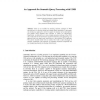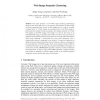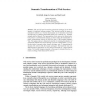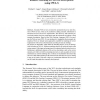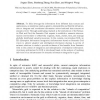OTM
2005
Springer
14 years 5 months ago
2005
Springer
UDDI is not suitable for handling semantic markups for Web services due to its flat data model and limited search capabilities. In this paper, we introduce an approach to allow for...
OTM
2005
Springer
14 years 5 months ago
2005
Springer
This paper provides a novel Web image clustering methodology based on their associated texts. In our approach, the semantics of Web images are firstly represented into vectors of t...
OTM
2005
Springer
14 years 5 months ago
2005
Springer
Abstract. Web services have become the predominant paradigm for the development of distributed software systems. Web services provide the means to modularize software in a way that...
KIVS
2005
Springer
14 years 5 months ago
2005
Springer
Abstract. Semantic Web services envision the automated discovery and selection of Web services. This can be realised by adding semantic information to advertised services and servi...
ISPA
2005
Springer
14 years 5 months ago
2005
Springer
An important precondition for the success of the Semantic Web is founded on the principle that the content of web pages will be semantically annotated. In this paper, we propose a ...
ICMI
2005
Springer
14 years 5 months ago
2005
Springer
This paper presents Latent Semantic Googling, a variant of Landauer’s Latent Semantic Indexing that uses the Google search engine to judge the semantic closeness of sets of word...
GCC
2005
Springer
14 years 5 months ago
2005
Springer
To fully leverage the information from different data sources and applications, an enterprise needs a generic, interoperable and flexible infrastructure to integrate and coordinate...
GCC
2005
Springer
14 years 5 months ago
2005
Springer
The Semantic Link Network model SLN and Resource Space Model RSM are semantic models proposed separately for effectively specifying and managing versatile resources across the Inte...
ESOP
2005
Springer
14 years 5 months ago
2005
Springer
: Fully abstract trace semantics for a core Java language. Alan Jeffrey 1,2 and Julian Rathke3 1 Bell Labs, Lucent Technologies, Chicago, IL, USA 2 DePaul University, Chicago, IL, ...
ESAW
2005
Springer
14 years 5 months ago
2005
Springer
In this paper, we discuss the development of a multi agent system working on the Semantic Web environment by using a new framework called SEAGENT. SEAGENT is a new agent developmen...
